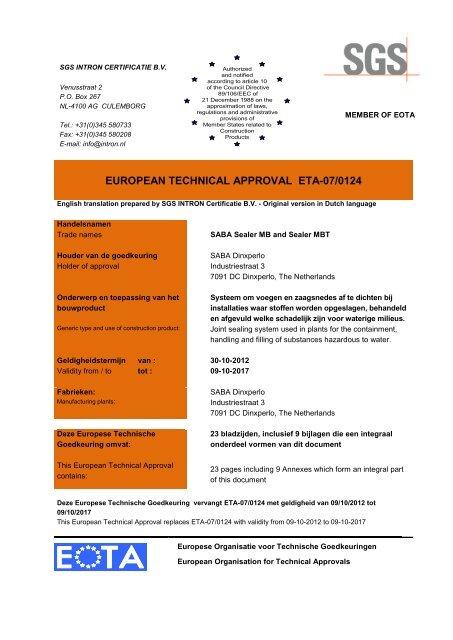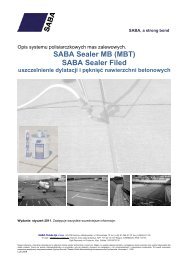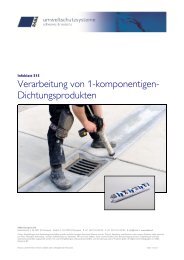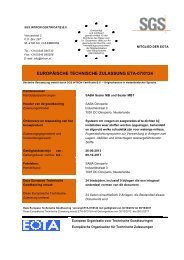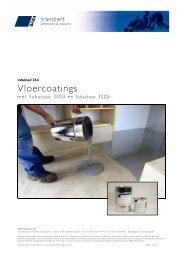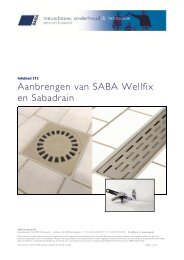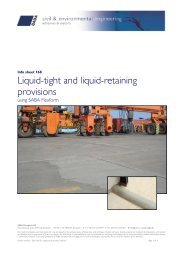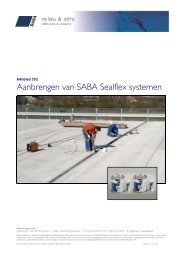EUROPEAN TECHNICAL APPROVAL ETA-07/0124 - Saba
EUROPEAN TECHNICAL APPROVAL ETA-07/0124 - Saba
EUROPEAN TECHNICAL APPROVAL ETA-07/0124 - Saba
Create successful ePaper yourself
Turn your PDF publications into a flip-book with our unique Google optimized e-Paper software.
SGS INTRON CERTIFICATIE B.V.Venusstraat 2P.O. Box 267NL-4100 AG CULEMBORGTel.: +31(0)345 58<strong>07</strong>33Fax: +31(0)345 580208E-mail: info@intron.nlAuthorizedand notifiedaccording to article 10of the Council Directive89/106/EEC of21 December 1988 on theapproximation of laws,regulations and administrativeprovisions ofMember States related toConstructionProductsMEMBER OF EOTA<strong>EUROPEAN</strong> <strong>TECHNICAL</strong> <strong>APPROVAL</strong> <strong>ETA</strong>-<strong>07</strong>/<strong>0124</strong>English translation prepared by SGS INTRON Certificatie B.V. - Original version in Dutch languageHandelsnamenTrade namesHouder van de goedkeuringHolder of approvalOnderwerp en toepassing van hetbouwproductGeneric type and use of construction product:Geldigheidstermijn van :Validity from / to tot :SABA Sealer MB and Sealer MBTSABA DinxperloIndustriestraat 37091 DC Dinxperlo, The NetherlandsSysteem om voegen en zaagsnedes af te dichten bijinstallaties waar stoffen worden opgeslagen, behandelden afgevuld welke schadelijk zijn voor waterige milieus.Joint sealing system used in plants for the containment,handling and filling of substances hazardous to water.30-10-201209-10-2017Fabrieken:Manufacturing plants:SABA DinxperloIndustriestraat 37091 DC Dinxperlo, The NetherlandsDeze Europese TechnischeGoedkeuring omvat:This European Technical Approvalcontains:23 bladzijden, inclusief 9 bijlagen die een integraalonderdeel vormen van dit document23 pages including 9 Annexes which form an integral partof this documentDeze Europese Technische Goedkeuring vervangt <strong>ETA</strong>-<strong>07</strong>/<strong>0124</strong> met geldigheid van 09/10/2012 tot09/10/2017This European Technical Approval replaces <strong>ETA</strong>-<strong>07</strong>/<strong>0124</strong> with validity from 09-10-2012 to 09-10-2017Europese Organisatie voor Technische GoedkeuringenEuropean Organisation for Technical Approvals
Page 2 of 23 – European Technical Approval <strong>Saba</strong> Sealer MB(T) <strong>ETA</strong>-<strong>07</strong>/<strong>0124</strong> – 30 October 2012I. LEGAL BASES AND GENERAL CONDITIONS1. This European Technical Approval is issued by INTRON Certificatie B.V. in accordance with:- Council Directive (89/106/EEC) 1 of 21 December 1988 on the approximation of laws,regulations and administrative provisions of Member States relating to constructionproducts, modified by the Council Directive 93/68/EEC of July 1993 2 and Regulation (EC)N° 1882/2003 of the European Parliament and of the Council 3 .- Common Procedural Rules for Requesting, Preparing and the Granting of EuropeanTechnical Approvals set out in the Annex of Commission Decision 94/23/EEC 4 .- Guideline for European Technical Approval of CUAP 06.05/11 “Joint sealing compoundsystems”2. SGS INTRON Certificatie B.V. is authorised to check whether the provisions of this EuropeanTechnical Approval are met. Checking may take place in the manufacturing plants.Nevertheless, the responsibility for the conformity of the products to the European TechnicalApproval and for their fitness for intended use remains with the holder of the EuropeanTechnical Approval.3. This European Technical Approval is not to be transferred to other manufacturers or agents ofmanufacturers other than those indicated on page 1, or manufacturing plants other than thoselaid down in the context of this European Technical Approval.4. This European Technical Approval may be withdrawn by SGS INTRON Certificatie B.V.pursuant to Article 5.1 of the Council Directive 89/106/EEC.5. Reproduction of this European Technical Approval including transmission by electronic meansshall be in full. However, partial reproduction can be made with the written consent of SGSINTRON Certificatie B.V. In this case partial reproduction has to be designated as such. Textsand drawings of advertising brochures shall not contradict or misuse the European TechnicalApproval.6. The European Technical Approval is issued by the Approval Body in its official language. Thisversion corresponds to the version circulated within EOTA. Translations into other languageshave to be designated as such.1 Official Journal of the European Communities nº L 40, 11.2.1989, p.122 Official Journal of the European Communities nº L 220, 30.8.1993, p.13 Official Journal of the European Union N° L 284, 31.10.2003, p. 254 Official Journal of the European Communities nº L 17, 20.1.1994, p.34
Page 3 of 23 – European Technical Approval <strong>Saba</strong> Sealer MB(T) <strong>ETA</strong>-<strong>07</strong>/<strong>0124</strong> – 30 October 2012II SPECIFIC CONDITIONS OF THE <strong>EUROPEAN</strong> <strong>TECHNICAL</strong> <strong>APPROVAL</strong>1 Definition of productThe <strong>Saba</strong> Sealer MB(T) joint sealing system, to be put in horizontal and vertical joints, is made of:1. Primer(s), see section below,2. Backfill material, not water absorbing and compatible with the joint sealing compound, “<strong>Saba</strong>Backfoam” or “<strong>Saba</strong> Rolyfoam PU”,3. Self-leveling joint sealing compound “<strong>Saba</strong> Sealer MB” (for horizontal application) or thethixotropic sealing compound “<strong>Saba</strong> Sealer MBT” (for mainly vertical application)”.Both sealer qualities are available in two shades: black and grey.The products will be designated in this document as Sealer MB, Sealer MBT and Sealer MB(T), thelatter when both types are included.The following primers are especially given by the manufacturer of the joint sealing system for therespective contact materials:1. “<strong>Saba</strong> primer 9102” for sealing constructions made of coated (only with a zinc rich primer) anduncoated metal, polymer materials such as hard PVC and polymer concrete.2. “<strong>Saba</strong> primer H17” for sealing constructions made of concrete (pre-cast or in situ) and for partsmade of semi-rigid pavements as well as the next contact materials:- Repair mortar “Betopox 012 WHG” (Epoxy based PC-mortar);- “StoCrete TG 203” (PCC)..3. "<strong>Saba</strong> primer 9911" for sealing constructions made of asphalt.The primers have to be applied to the joint sidewalls before the joint sealing compound is applied.The approved joint geometry (defined ratio of thickness and width) is presented in Annex 1. Thejoint sealing compound is suitable to be directly applied on already hardened, dry and clean SealerMB(T) joints. The joint sealing compound is applied in a plastic state and reacts to form a sealantwith predominantly elastic properties.
Page 4 of 23 – European Technical Approval <strong>Saba</strong> Sealer MB(T) <strong>ETA</strong>-<strong>07</strong>/<strong>0124</strong> – 30 October 20122 Intended use and working lifeThe intended use for the considered joint sealing system is for the use in liquid proof installationsfor the containment, handling and filling of water contaminating substances. These constructionsmay be both inside buildings or under a roof only as well as in the open air. They can be exposedto simultaneous or succeeding effects of different chemicals, deformation movements,temperature, weather, traffic, et cetera.The joint sealant system can be used to repair existing installations.Without an adverse effect on the sealing function, the joint sealing constructions:are to be installed at normal environmental, structural element and material temperatures(usually within a range of +5°C to +40°C).are intended to be used:o both internally and externally at temperatures between -20°C and +70°C,o for sealing of movement joints, which shall allow unrestrained deformation ofstructural elements as a result of thermal or hygric shrinkage and expansion and ofmechanical deformation of the construction or of the sub base, et cetera,o under constantly changing mechanical actions in liquid proof installations, whichare at the same time trafficable.2.1 Intended working lifeThe provisions, assessment methods and the verification included or referred to in this <strong>ETA</strong> havebeen written based upon the intended working life of the joint sealing system for the intended useof 10 years. These indications given as to the working life of the joint sealing system cannot beinterpreted as a guarantee given by the product manufacturer or his representative or the approvalbody issuing the <strong>ETA</strong>, but are regarded only as an aid in choosing the appropriate products inrelation to the expected economically reasonable working life of the works.
Page 5 of 23 – European Technical Approval <strong>Saba</strong> Sealer MB(T) <strong>ETA</strong>-<strong>07</strong>/<strong>0124</strong> – 30 October 20123 Performance of the product and methods of verification3.1 GeneralThis <strong>ETA</strong> is issued for SABA on the basis of the information deposited at SGS INTRON CertificatieB.V..Assessment of the fitness of the sealing joint system “Sealer MB(T)” for the intended use, withregard to Essential Requirements 2 and 3, was performed in compliance with the CUAP “Jointsealing compound systems”, <strong>ETA</strong> request No. 06.05/11, final version 04/2004.This assessment could be extended with other requirements applicable to:dangerous substances resulting from transposed European legislation or national regulationsand administrative provisions,the products, resulting from the application of other national regulations and administrativeprovisions.General:the joint sealing system shall correspond to the drawings and the details of the annexes of this<strong>ETA</strong>,the chemical composition or the formula of the primers, joint sealing compound and backfillmaterial shall correspond to the technical information deposited with SGS INTRON CertificatieB.V.,the characteristics of the materials, dimensions and tolerances which are not declared in this<strong>ETA</strong> shall correspond to the information laid down in the technical documentation of this <strong>ETA</strong>.3.2 CharacteristicsThe joint sealing system:- is resistant to the liquids listed in Annex 2 and prevents the migration of these liquids in the areaof the joint under consideration of the details presented in Annex 3,- is resistant to hydrolysis and weather,- is suitable for materials and constructions listed in Annex 5,- is suitable to be directly applied onto already hardened polysulfide joints,- meets the requirements of the reaction-to-fire class E conform EN 13501-1,- meets the requirements for the level of traffic for sealing areas of:- asphalt “t0”: Pedestrians;- other materials (e.g. concrete) “t0” and “t1”: Pedestrians and pneumatic tyred vehiclesSee also annex 1,- is, without becoming leaky, able to take up the extension-, compression- and shear-deformationsdocumented in Annex 6,- meets the requirements for the slipping behaviour at built-in-state at temperature actions of up to200°C.
Page 6 of 23 – European Technical Approval <strong>Saba</strong> Sealer MB(T) <strong>ETA</strong>-<strong>07</strong>/<strong>0124</strong> – 30 October 20123.3 CompositionThe joint sealing system is made of:Primer:- One part silane based “<strong>Saba</strong> primer 9102” for sealing constructions made of coated (only with azinc rich primer) and uncoated metal and of polymer concrete based on unsaturated polyester.- Two part epoxy based “<strong>Saba</strong> primer H17” for sealing constructions made of concrete (pre-castor in situ) and for parts made of semi-rigid pavements as well as the next contact materials:- Repair mortar “Betopox 012 WHG” (Epoxy based PC-mortar);- “StoCrete TG 203” (PCC).- Two part epoxy based "<strong>Saba</strong> primer 9911" for sealing constructions made of asphaltSealing compound:Polysulfide based 2 part joint sealing compound “Sealer MB(T)”.Backfill material:A closed-cell polyethylene based backfill material “<strong>Saba</strong> Backfoam” or open-cell polyurethanebased material “<strong>Saba</strong> Rolyfoam PU”. This backfill material should be used in accordance with theprovisions of <strong>Saba</strong> and Annex 1. The backfill material:- prevents the adhesion of the sealing compound on the bottom of the joint,- shall be installed sufficiently stable (to resist the installation of the joint sealing compound, etc.),with the same height “d” and result in a lower convex shaped surface of the joint sealingcompound,- may not cause loss of adhesion of the sealing compound on the side walls and may not causediscolorations or bubbles.
Page 7 of 23 – European Technical Approval <strong>Saba</strong> Sealer MB(T) <strong>ETA</strong>-<strong>07</strong>/<strong>0124</strong> – 30 October 2<strong>0124</strong> Evaluation of Conformity and CE marking4.1 Attestation of the System of conformityThe European Commission, according to the decision on the Procedures of Attestation ofConformity 2003/656/EC of 12 September 2003 (Official Journal of the European Union No L 231of 17 September 2003), has laid down for this type of material system (joint sealing compounds) aSystem 2+ for the procedure of attestation of conformity (AoC).The AoC system 2+ provides:a) Tasks for the manufacturer Initial type-testing of the joint sealing compound and the primer(s), Factory production control including continuous testing of samples taken at the factory.b) Tasks of the approved bodiesInspection Body:Initial inspection of the factory production control. Continuous surveillance, assessment and approval of factory production control.Certification Body:Granting of a certificate of conformity.4.2 Responsibilities4.2.1 Tasks of the manufacturer4.2.1.1 Factory production controlThe manufacturer shall set up a prescribed test plan and exercise permanent internal control ofproduction and ensure that:- the results obtained comply with the quality level required,- the produced materials correspond to the provisions of the <strong>ETA</strong>.All the elements, requirements and provisions adopted by the manufacturer are documented in asystematic manner in the form of written procedures and regulations. This documentation shallensure a common understanding of quality assurance and enables the achievement of the requiredproduct characteristics according to the <strong>ETA</strong>. The manufacturer shall control the initial materialsaccording to the prescribed test plan and only use initial materials that comply.The results of the factory production control shall be recorded and evaluated. The records shallinclude at least the following information:Name of the product and of the initial materials,Type of inspection or test,Date of manufacture of the product, batch number, and date of inspection or control of theproduct/initial material,Result of inspections or controls and, as far as applicable, comparison with requirements,Signature of the person responsible for factory production control.The records shall be kept for at least 5 years.
Page 8 of 23 – European Technical Approval <strong>Saba</strong> Sealer MB(T) <strong>ETA</strong>-<strong>07</strong>/<strong>0124</strong> – 30 October 2012Further information concerning tests, their frequency and tolerances, is included in this test plan,which forms part of the technical information of this <strong>ETA</strong> and is deposited at SGS INTRONCertificatie B.V. This information shall be supplied to the approved body for the evaluation ofattestation of conformity.4.2.2 Tasks of the Inspection Body4.2.2.1 Initial inspection of factory and production control.The approved Inspection Body ascertains that, in accordance with the CUAP, factory conditionsand production control allow the manufacturer to ensure the consistency and homogeneity of themanufactured product and its traceability. Thus guaranteeing that the final characteristics of thejoint sealing system are those indicated in chapter 3 of this <strong>ETA</strong>.4.2.2.2 Continuous surveillance, assessment and approval of Factory Production ControlThe approved Inspection Body shall visit the producer at least twice a year. Surveillance of themanufacturing process shall include a continuously assessment of the effectiveness of the factoryproduction control in accordance with the requirements of the test plan:Checking the documentation of factory production control, to ensure continuing compliancewith the provisions of the <strong>ETA</strong>, Identification of changes by comparing data obtained during the initial inspection or during thelast inspection;In cases where the <strong>ETA</strong> provisions and the control plan are no longer fulfilled, the certificate ofconformity shall be withdrawn.4.2.3 Certification BodyThe certification of the factory production control by a approved Certification Body is based on theresults of:- Initial inspection of the factory production control.- Continuous surveillance, assessment and approval of factory production control.4.3 CE MarkingCE marking 5 shall be affixed on the packaging of the joint sealing system and in addition to the“CE” symbol, the following information shall be supplied by the manufacturer:- Identification number of notified certification body,- Name or identifying number of producer and manufacturer,- The last two digits of the year in which the marking was affixed,- Number of European Technical Approval (<strong>ETA</strong>),- Number of the certificate of conformity (system 1) and the number of the certificate on the factoryproduction control (system 2+),- Statement on the presence of harmful substances included concentration,- Name (including consistence) and colour of the product,- Characteristics of the product according to the <strong>ETA</strong>,- Level(s) or class(es) in case of reaction to fire.5 Remarks:- Notes on the CE marking are stated in Guidance Paper D of the European Commission "CE marking under theConstruction Products Directive", Brussels May 2004.- Clause 9 of CUAP.
Page 9 of 23 – European Technical Approval <strong>Saba</strong> Sealer MB(T) <strong>ETA</strong>-<strong>07</strong>/<strong>0124</strong> – 30 October 20125 Assumptions under which the fitness for the product is assessed5.1 ManufactureThe production of the individual components of the joint sealing compound and primers shall be inaccordance with the details deposited with SGS INTRON Certificatie B.V. and carried out at theproduction location of <strong>Saba</strong>: SABA Dinxperlo, Industriestraat 3, 7091 DC Dinxperlo, TheNetherlands. Changes to the product or in the production process of the components are subject ofprior consent by SGS INTRON Certificatie B.V. before the changes are introduced. SGS INTRONCertificatie B.V. will decide whether or not such changes affect the <strong>ETA</strong>, effect the validity of theCE marking on the basis of the <strong>ETA</strong> and if further assessment/alterations to the <strong>ETA</strong> shall benecessary.5.2 Installation5.2.1 Conditions for installation:- The choice for the joint sealing system is based on:o The contact material,o The indicated levels and/or performance classes (users categories),o Controllable calculations and construction drawings, based on:• stresses and loadings to be expected,• requirements and provisions of the respective country,• the admissible extension, compression and shear distances referred to inAnnex 6.- The joint sealing system is designed by expert designers and the function of the joint sealingsystem is controllable during it’s service life,- The design of the joint sealing system ensures that there are no joint sealing systems in theimmediate area of filling points and accumulation on the joint sealing system of dirt and liquidshazardous to water are avoided,- The joint sealing system does not insulate conductive parts,- The joint side walls should be able to withstand the occurring forces and stresses of the jointsealing system,- The admissible deformations of the liquid proof surfaces/constructions to be connected,presented in Annex 6, are complied with,- The characteristic penetration depth of the respective liquid in the surfaces/constructions to beconnected shall not exceed d h (Annex 3),5.2.2 Processing:- Installation of the joint sealing system is only permitted to firms who are trained and authorisedby the manufacturer. Further requirements can result from national provisions of the respectivecountry.- <strong>Saba</strong> has drawn up installation and handling instructions. These are deposited with SGSINTRON Certificatie as a part of the technical information. The joint sealing system should beapplied according to these instructions and to the provisions of this <strong>ETA</strong>. Additionalinstructions and advice concerning for example the condition of the side walls of the jointshould also be paid attention during the installation of the joint system.
Page 10 of 23 – European Technical Approval <strong>Saba</strong> Sealer MB(T) <strong>ETA</strong>-<strong>07</strong>/<strong>0124</strong> – 30 October 20125.2.2.1 Before installation:- The suitability of the joint side walls are ascertained (strength, dry, clean, etc.),- It is guaranteed that the maximum joint width will not exceed the admissible joint width (Annex3)- Concrete to be sealed shall be at least 7 days old and shall have reached at least 70% of the28 days strength,- Accumulation of dirt, etc. under the joint sealing system is avoided and shall be removedthoroughly before installation.5.2.2.2 During installation:- The specifications of the manufacturer and designer of the joint sealing system are met,- The surface temperature is at least 3°C above dew point,- The temperature is above 5°C and below 40°C,- The surface to be treated is dry and clean,- The primer is applied on both joint side walls,- The time between the application of the primer and joint sealing compound is according to thespecifications of the manufacturer (time interval presented in Annex 4),- Both the primer and the joint sealing compound are applied as uniform and blister free aspossible and the chamfer edges, when present, are left free- To be able to withstand all stresses and loads both the primer and joint sealing compoundshould be protected during curing against mechanical, climatic and mechanical stresses. Therequested curing time is presented in Annex 4.- The attestation of conformity of the installed sealing construction will be performed by theinstalling firm conform Annex 8 (production report).5.2.2.3 Repair works:- Repair of the joint sealing system is only authorised for firms who are trained and authorisedby the manufacturer. Further requirements can result from national provisions of the respectivecountry.- The section to be repaired will be separated by a vertical cut from the intact sections,- Defective materials shall be removed completely,- Before use, the suitability of the repair systems shall be assessed. In particular the suitabilityof repair systems based on concrete with polymeric additives. The suitability of these materialsshall be assessed conform the CUAP.- The provisions and requirements of 5.2.2.1 and 5.2.2.2 are observed.5.2.2.4 Control of the installation and repair worksBefore installation:- For liquid proof installations made of concrete: are the strength class and water cement ratioaccording to EN 206 and/or the national provisions of the respective country?- Are the joint width, the joint distance and the joint depth according to the provisions presentedin Annex 1 and 3 and/or the provisions of the manufacturer?- Are the joint side walls suitable (strength, dry, clean, free of cracks)?- Is the joint free from accumulations of dirt, dust, etc.?- Are the application conditions and the surface temperature conform the provisions of themanufacturer?
Page 11 of 23 – European Technical Approval <strong>Saba</strong> Sealer MB(T) <strong>ETA</strong>-<strong>07</strong>/<strong>0124</strong> – 30 October 2012After installation:- Is the joint sealing system uniform applied, blister free and are the prescribed chamfer edgespresent (visual inspection)?- Examination of the adhesion of the joint sealing system in full length with one of the followingtest methods:o Ball Stick testImpressing the joint for appr. 2 mm with a hemispherical rounded stick. The stickwidth is half a joint width.o Pulley testImpressing the joint for appr. 2 mm with circular metal disc. The disc width is half ajoint width. The disc is provided with an axle to be able to perform the testcontinuously by pulling the disc slowly over the joint sealing system.5.2.3 Responsibilities manufacturerThe manufacturer is responsible to make sure that all those who use the joint sealing system areinformed adequately according to:- The installing and processing instructions by the manufacturer,- The not confidential part of the technical information of this <strong>ETA</strong>.This information can be given by reproduction of the corresponding parts of this <strong>ETA</strong>.6 Recommendations6.1 Packaging, transport and storage- Storage in closed original package and the maximum storage time indicated on the packageshall be observed,- Storage at temperatures between +10°C and +40°C, free from moisture and exposure to directsunlight,- The information and requirements on the packaging shall be observed.6.2 Use, maintenance and repairIn order to ensure the fitness for use during the service life the following measures arerecommended:- All parties involved are adequately informed (task of the manufacturer),- The joint sealing system is driven over only with vehicles with pneumatic tyres,- Reference is made for the necessity of a permanent surveillance by the operator of the plantfor tightness and operability of the joint sealing system in accordance with the nationalregulations of the respective country,- The operator of the plant establishes operating instructions including descriptions of thenecessary measures:o To inspect the condition of the joint sealing systems. Inspection intervals andmethods are prescribed in Annex 2 and 9.o To ensure proper operation,o For maintenance and repair,o To be taken in case of damage.- Dripping losses and/or accumulations are directly removed in the prescribed way. Appropriatematerials, methods and devices are always sufficient available.
Page 12 of 23 – European Technical Approval <strong>Saba</strong> Sealer MB(T) <strong>ETA</strong>-<strong>07</strong>/<strong>0124</strong> – 30 October 2012- Before the plant is taken into use or after repair works the following inspections have to beperformed:o Start-up inspection is performed by trained and authorised experts only,o The responsible inspectors are given the possibility to participate in the controlsbefore, during and after the installation of the joint sealing systems and willconstantly be kept informed on the process.o The responsible inspector examines the following intended inspection intervals:• One year after the start-up inspection,• Every following five year a maintenance inspection.These inspections shall be performed as follows:• Carried out by trained and authorised experts,• Conform 5.2.2.4., if necessary (leaky or not?) additional testing can beperformed (drilling cores, samples of the soil underneath the construction,etc.).o National regulations and provisions of the Member States shall be observed.- All essential measures of control, maintenance, repair and stress levels will be specified inoperating constructions. Results will be recorded and will be presented to the personsresponsible according the national regulations.For SGS INTRON Certificatie B.V.ing. R. WooninkCertification manager
Page 13 of 23 – European Technical Approval <strong>Saba</strong> Sealer MB(T) <strong>ETA</strong>-<strong>07</strong>/<strong>0124</strong> – 30 October 2012ANNEX 1: Joint sealing system geometryPermissable dimensionsnot trafficable jointconstruction:10 mm < b < 40 mmd=0,8-1,0 x bd H = d + 0,50 bt = 1,5b + dFigure A1a: not trafficable joint constructionFigure A1b: trafficable joint constructiona = chamfer edge (3-5 mm)b = joint widthd = thickness of the joint sealing compoundd H = joint sealing compound bonding or contact surface on the joint side wall ( = d + 0,5 b)Figure A1c: detail APermissable dimensionstrafficable joint construction:10 mm < b < 20 mmd=0,8-1,0 x bd H = d + 0,50 bt = 1,5b + dt = the required depth to insure enough room for both backing material and sealant (= 1,5 b + d)TABLE A1: DIMENSIONS OF THE JOINT CONSTRUCTIONb d d H t APPLICATIONp[mm]10 – 20 8 – 20 13 – 30 23 – 50 Trafficable10 – 40 8 – 40 13 – 60 23 – 100 Not Trafficable
Page 14 of 23 – European Technical Approval <strong>Saba</strong> Sealer MB(T) <strong>ETA</strong>-<strong>07</strong>/<strong>0124</strong> – 30 October 2012Annex 2: List of liquidsTABLE A2: LIST OF LIQUIDSGroupDF 1 Gasoline for spark ignition engines, super and normal (according to EN 228:2004-03)with a maximum of 5 percent by volume of bio-alcoholDF 1a Gasoline for spark ignition engines, super and normal (according to EN 228:2004-03)with a maximum of 20 percent by volume of bio-alcoholCRS3, H3, F3S3, H3, F3DF 2 Aviation fuels S2, H2, F2DF 3 - Fuel oil EL (DIN 51603-1)- Unused combustion motor oil- Unused automotive transmission oil- Mixture of saturated and aromatic hydrocarbons with an aromaticcontent ≤ 20 wt% and a flash point > 55°CS3, H3, F3DF 3a Diesel fuel (according to EN 590) with a maximum of 5 percent by volume of biodiesel S3, H3, F3DF 3b Diesel fuel (according to EN 590) with a maximum of 20 percent by volume of biodiesel S3, H3, F3DF 4 All hydrocarbons as well as mixtures containing benzene with max. 5 vol.% benzene S2, H2, F2DF 4a Benzene and benzene containing mixtures (incl. 4) S2, H2, F2DF 4b Crude oils S2, H2, F2DF 4cDF 5Used combustion motor oil and used automotive transmission oil with a flash point> 55°CMono- and polyfunctional alcohols (up to a maximum of 48 vol.% methanol), glycolethersS2, H2, F2S3, H3, F3DF 5a All alcohols and glycol ethers S2, H2, F2DF 5b Single and polyfunctional alcohols S2, H2, F2DF 7 All organic esters and ketones S2, H2, F2DF 7a Aromatic esters and ketones S2, H2, F2DF 7b Biodiesel fuel S3, H3, F3DF 8 Aqueous solutions of aliphatic aldehydes up to 40% S2, H2, F2DF 8a Aliphatic aldehydes and their aqueous solutions S2, H2, F2DF 9 Aqueous solutions of organic acids (carboxylic) up to 10% as well their salts S2, H2, F2DF 10DF 11Mineral acids up to 20% as well as acidic hydrolyzed inorganic salts in aqueous solution(pH < 6), except for hydrofluoric acids and acids with an oxidizing effect and their saltsInorganic alkalis as well as alkaline, hydrolyzed inorganic salts in aqueous solution(pH > 8), except for ammonium solutions and solutions of salts with an oxidizing effect(e.g. hypochlorite)S3, H3, F3S3, H3, F3DF 12 Aqueous solutions of inorganic non-oxidizing salts with a pH-value between 6 and 8 S3, H3, F3- Skydrol S2, H2, F2DF 13 Amines and their salts (in aqueous solution) S1, H1, F1- Adblue, max. 35% urea in aqueous solution S3, H3, F3- Fuel E85, a fuel blend of 85 percent bio-ethanol and 15 percent gasoline S3, H3, F3CR =Chemically Resistant up to the stress levels (see annex 9)
Page 15 of 23 – European Technical Approval <strong>Saba</strong> Sealer MB(T) <strong>ETA</strong>-<strong>07</strong>/<strong>0124</strong> – 30 October 2012Annex 3: Migration behaviourett t kFigure A3b:definition of migration depthe tk = e tm *1.35e tk < d HFigure A3a:migration behaviour and penetration depth of test liquidsb = joint widthd = thickness of the joint sealing compoundd H = adhesive or contact surface of the joint sealing compound at the joint side wall ( = d + 0,5 b), see figure A1be tm = the average penetration depth of the liquide tk = the characteristic penetration depth of the liquid ( = e tm . 1,35)
Page 16 of 23 – European Technical Approval <strong>Saba</strong> Sealer MB(T) <strong>ETA</strong>-<strong>07</strong>/<strong>0124</strong> – 30 October 2012Annex 4: Characteristics of the materialsTABLE A4 : CHARACTERISTICS OF MATERIALSNo. Characteristics/levels/ classes Unit Characteristic value for the joint sealing systemContact materials- (Un)coated metal- hard PVC- Polymer concrete(unsaturatedpolyester, UP)- Concrete- Semi-rigidpavement- “Betopox 012WHG” (PCmortar);- “StoCreteTG 203” (PCC)Asphalt1 Primer - Primer 9102 Primer H17 Primer 99112 Open time before application ofthe sealing compound (at 23°C):- minimum- maximumminuteshours10243063063 Maximum storage time (originalunopened packaging)- Primer- Sealer MB black & grey- Sealer MBT black & greymonths1818618186121864 Mixing ratio:- Primer- Sealer MB(T) black, MB grey- Sealer MBT greypartsbyweight1 component100 A + 9 B100 A + 7 B100 A + 30 B100 A + 9 B100 A + 7 B100 A + 16 B100 A + 9 B100 A + 7 B5 Pot life (at 23°C):- Primer- Sealer MB(T) black & greyhours1 component1.52 – 31.52 – 31 .56 Primer coverage g/m 2 ca. 100 (depending on the substrate)7 Minimum curing time (at 23°)before use: hours 48 48 488 Colour:- Primer- Sealer MB(T) black & grey--TransparentBlack or greyYellowBlack or greyYellowBlack or grey9 Backfill material - <strong>Saba</strong> Backfoam / Rolyfoam PU10 Conditions during installation:- Surface temperature- Ambient temperature- Sealer temperature°C°C°C≥ 3 above dew point5 – 40≥ 1011 Reaction to fireaccording to EN 13501-1: class E E E
Page 17 of 23 – European Technical Approval <strong>Saba</strong> Sealer MB(T) <strong>ETA</strong>-<strong>07</strong>/<strong>0124</strong> – 30 October 2012Annex 5: Contact materialsAdmissible contact materials:- Uncoated steel,- Coated steel (with a zinc rich primer),- Concrete (pre cast or in-situ, optionally with steel fibre reinforcement),- Asphalt,- Semi-rigid pavements,- Polymer concrete (unsaturated polyester based),- “Betopox 012 WHG” (PC-mortar);- “StoCrete TG 203” (PCC)All admissible contact materials are according to:- The statutory provisions implementing directives of the European Community including:o the specific requirements of the building authorities,o the law relating to water which bear the CE marking,and/or- According to the intended national requirements of the respective countries for the use inplants for the containment, handling and filling of substances hazardous to water.Additional requirement Coated steelSteel coated with a zinc rich primer for the required corrosion protection.
Page 18 of 23 – European Technical Approval <strong>Saba</strong> Sealer MB(T) <strong>ETA</strong>-<strong>07</strong>/<strong>0124</strong> – 30 October 2012Additional requirements ConcreteUncoated, liquid proof concrete shall at least fulfil the following requirements:TABLE A5 : ADDITIONAL REQUIREMENTSNo. Property ClassificationReferencestandardComments11.1Consistency classes;Compactability classC3EN 206-1Table 5Degree of compactability;1.10 to 1.04Softer consistencies may only be usedif fit is verified that segregation isavoided under the respective conditionsof installation given.1.2 Slump class F3 E 206-1Table 6Slump:420 to 480 mm2 Compressive strengthclass≥C30/37≤C50/60EN 206-1Table 7Applies for XA3 and XM33 Max. permissible w/cratio≤0,5 EN 206-1Table F.144.1CementMinimum content320 kg/m³according toEN 206-1Table F.1Maximum content: 360 kg/m³4.2 Minimum contentWhen taking intoconsideration mineraladditives270 kg/m³ according toEN 206-1Table F.1Fly ash 1)Can be added to other mineralaggregates than fly ash4.3 Type CEMІ , II and III5 Aggregate 8 ≤ D max ≤16 mmEN 206-1Section 5.2.2EN 206-1Section 5.2.3.and EN 12620In accordance with EN 197-1:2000except:CEM II/B-PCEM II/A and B-W,CEM II/A and B-LL,CEM II/B-L,CEM II/A and B-M6 Other requirements With the use of- Plasticising additives and- FibresThe suitability shall be verifiedAdditionallyfor D it is verified with AllgemeineBauaufschtliche Zulassung(national technical approval)1) remark:Powder coal fly ash, which comply with the requirements of EN 450, may be used whereby the following additionalconditions must be fulfilled:W< 0.5Z + 0.4 fWhere the content of the fly ash may equal f < 0.25 z
Page 19 of 23 – European Technical Approval <strong>Saba</strong> Sealer MB(T) <strong>ETA</strong>-<strong>07</strong>/<strong>0124</strong> – 30 October 2012Annex 6: Admissible deformationThe admissible deformation (compression/extension and/or shear) of the joint sealing compound is25%, see table for examples:Original jointwidth (mm)Maximumdeformation (mm)Min/max deformedjoint width (mm)8 2 6 – 1010 2,5 7,5 – 12,512 3 9 – 1514 3,5 10,5 – 17,516 4 12 – 2018 4,5 13,5 – 22,520 5 15 – 2530 7,5 22,5 – 37,540 10 30 – 50Combined compression/extension and shearThe following equation may be used for combined compression/extension and shear:X 2 S,pX 2 SX 2 DS,p+ ≤ 1X 2 DSWithX S, p = expected shearX S = allowed shearX DS,p =expected compression/extensionX DS = allowed horizontal deformation
Page 20 of 23 – European Technical Approval <strong>Saba</strong> Sealer MB(T) <strong>ETA</strong>-<strong>07</strong>/<strong>0124</strong> – 30 October 2012Annex 7: Examples of joint constructions
Page 21 of 23 – European Technical Approval <strong>Saba</strong> Sealer MB(T) <strong>ETA</strong>-<strong>07</strong>/<strong>0124</strong> – 30 October 2012
Page 22 of 23 – European Technical Approval <strong>Saba</strong> Sealer MB(T) <strong>ETA</strong>-<strong>07</strong>/<strong>0124</strong> – 30 October 2012Annex 8: Example of an installation reportConfirmation by the executing company1. Project – Name……………………………………………………………………………………………………………– Size ……….. ………………………………………………………………………………………………….2. Storage substance: ……………………………………………………………………………………………………………..3. Joint sealing system : SABA Sealer MB(T) black / greyas a component of the joint sealing system of SABA Dinxperlo b.v. used in plantsfor the containment, handling and filling of substances hazardous to water4. Approval: <strong>ETA</strong>-06/XXXX5. Manufacturer SABA Dinxperlo b.v.Weverstraat 6NL-7091 CM DinxperloPhone: +31 (0)315 658999Fax: +31 (0)315 6589896. Name of company installing according to <strong>ETA</strong> section 4.2.2. (1):…………………………………………………..…………………………………………………..…………………………………………………..7. Construction period …………………………………………………..8. The qualified personnel of the executing company was instructed by the holder of the European Technical approvalmentioned above in the proper processingAffirmation:9. Evaluations and controls before and during the installation of the joint sealing systema) Before installation:- joint width / joint distance / depth of the joint space (mm): ……/……/……- surface temperature / thawing temperature (°C): ……/……- bond areas/contact areas are dry: yes/no- bond areas/contact areas are free from all contaminations yes/no- system component in accordance with approval yes/no- making of all components in accordance with the approval yes/nob) During and after installation- Records of the weather conditions are enclosed yes/no- Visual test objections / no objections- side wall adhesion according to section 4.2.4(3) objections / no objectionsRemarks:Date:……….Signature and firm stamp:……………..
Page 23 of 23 – European Technical Approval <strong>Saba</strong> Sealer MB(T) <strong>ETA</strong>-<strong>07</strong>/<strong>0124</strong> – 30 October 2012Annex 9: Stress levelsLevels of chemical exposureThe levels of chemical exposure have been chosen in accordance with table A9.1 en A9.2 ( seealso table 5.1of the CUAP). The tables are given below and describes the time during which theaffecting liquid is permitted to act on the joint sealing system as well as the corresponding timeduring which the affecting test liquid acts on the joint sealing compound during the test.TABLE A9.1.STRESS LEVEL RELATED TO THE PERIOD OF STRESS DURING STORAGE IN A TEST LIQUIDLevelsof exposureDescription Period of exposure Test periodS1S2S3LowMeanHighTo 8 hoursTo 72 hoursTo 3 months8 hours72 hours≥21 days 1)TABLE A9.2.STRESS LEVEL RELATED TO THE FREQUENCY OF FILLING AND/OR HANDLING PERIOD OF TEST LIQUIDSLevelsof exposureDescription Period of exposure Test periodH1, F1H2, F2H3, F3LowMeanHighMax. 4 times a yearMax. 200 times a yearMore than 200 times a year8 hours72 hours≥21 days 1)1) Note table A9.1 and A9.2As far as no change recognisable. Otherwise the test can be prolonged up to the stability of mass, however up to 42days in maximum.


